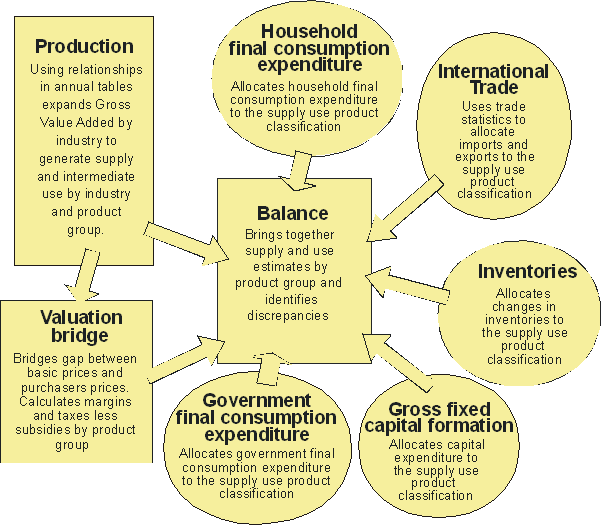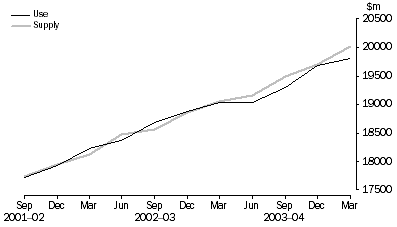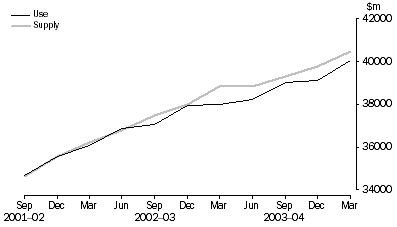Feature Article - Supply and Use Table and the Quarterly National Accounts
INTRODUCTION
This article describes the development of quarterly supply and use tables, which are a tool to assist in the compilation of quarterly national accounts. Specifically, the quarterly supply and use tables are used to increase the coherency of the quarterly estimates, by systematically assessing the discrepancies between the three independent measures of GDP that underpin the quarterly national accounts.
BACKGROUND
In 1998, as part of its implementation of SNA93, the ABS introduced balanced annual estimates of gross domestic product (GDP) in both current prices and in volume terms. Balanced estimates are available from 1994-95 to the year prior to the latest complete financial year. A balanced estimate of GDP implies there are no statistical discrepancies between the three approaches to measuring GDP, namely:
- the expenditure approach, GDP(E) i.e. summing final expenditures less imports
- the production approach, GDP(P) i.e. summing the gross value added of each industry
- the income approach, GDP(I) i.e. summing factor incomes.
The annual estimates of GDP and its components are compiled in supply and use tables by a process of confronting and balancing the supply and use of goods and services. This ensures that final domestic expenditures, intermediate usage and exports are consistent with output and imports, and that the incomes and gross value added of each industry are the same.
Quarterly estimates of GDP are not compiled in a supply and use framework and are unbalanced. However, the quarterly current price and chain volume estimates are constrained to sum to the balanced annual estimates. This has resulted in a reduction in the absolute size of the quarterly statistical discrepancies. Nonetheless differences in both levels and quarter-to-quarter movements still remain between the three independent measures of quarterly GDP. It should be noted that the official measure of GDP used in the Australian quarterly national accounts (QNA) is the average of the three measures. Statistical discrepancies are recorded in order to achieve accounting equivalence between the official measure and that derived using the three independent approaches.
COMPILATION PRACTICE FOR THE QUARTERLY NATIONAL ACCOUNTS
A large variety of survey and administrative data are used to compile the QNA. Any inconsistencies or gaps remaining in the data are ultimately reflected as statistical discrepancies. The national accounts compilation process incorporates a review process designed to highlight inconsistencies and improbable movements in the data. Problems are identified, investigated and resolved in an iterative manner in the process of finalising the estimates of GDP.
Over the past two years the ABS has developed and trialled a quarterly supply and use (QSU) model as an editing tool to assist in the preparation of the QNA. A QSU model enables inconsistencies between the different measures of GDP to be identified and investigated more systematically, and at a greater level of detail, than is possible by simply examining the aggregate estimates. At the present stage of its development, the QSU model is used as an aid in the compilation of the seasonally adjusted chain volume production and expenditure based estimates of GDP. As we gain experience with its use, the model may be extended in the future to incorporate current price estimates, including income based estimates. This paper describes how the QSU model works and how it is used to help edit the quarterly national accounts.
THE QSU MODEL
The QSU model is specifically designed for use with the quarterly national accounts. In the quarterly system GDP is estimated at a relatively high level of aggregation so the source of discrepancies between the three measures of GDP may not be evident. The QSU model expands the level of detail in the system in order to articulate the relationships between the different measures of GDP and thus help to identify the source of differences.
The QSU model is built around the supply and use relationships in the reference year annual supply use tables. By and large, the input data are the existing QNA outputs together with a limited amount of additional primary data, such as imports and exports data by product. Using these data, the model generates the additional detail required to complete the supply and use tables for each quarter of the estimation period. It assumes that the supply and use relationships in the annual tables hold over the QSU estimation period. Subject to that key assumption, the tables are used to identify discrepancies between the supply and use of products which can then be investigated and resolved as far as possible prior to publication. The reference year supply and use relationships are brought forward annually in the June quarter and are used until the March quarter of the following year.
To accommodate the time dimension of the QNA, the QSU tables have been configured as time series. Supply and use tables are conventionally presented as two tables, a supply table showing the supply of products by industry of origin, and a use table showing the intermediate use of products by industry and final use by type of expenditure. The tables relate to a single time period, usually a year. This type of presentation is designed primarily for cross sectional analysis of relationships between industries and products, but is not ideal in an environment where changes in economic activity over time are the main focus of interest.
In the QSU model the two basic tables have been expanded to create a suite of interrelated tables with each table having a time dimension covering the total estimation period. The model includes separate tables for supply and intermediate consumption by industry and the various final expenditure aggregates. Trade and transport margins and net taxes on products form a bridge between supply at basic prices and use at purchasers' prices and have separate tables. The estimates from the various tables feed into balancing tables showing the supply and use of products, and the discrepancies between total supply and total use.
The model is based on the national accounting identity that, in concept, GDP calculated by the production approach is equal to GDP calculated by the expenditure approach. GDP calculated by the production approach is equal to the value of goods and services produced (output) less the cost of goods and services used up in the production process (intermediate consumption). In the Australian national accounts output is measured in basic prices and hence taxes less subsidies on products must be added to obtain GDP at purchasers' prices. GDP as estimated by the expenditure approach is equal to the sum of all final expenditures, changes in inventories and exports less the value of imports of goods and services. The chart below shows the main elements of the QSU model and the flows into the balancing tables.

The table below uses the balancing table for health products to illustrate the format. Health products are a relatively simple group, with most supply being in the form of services provided by the health industry and use being dominated by government and household final consumption expenditure.
Supply and use of health services, Chain volume measures |
|  |
 | 2001-02 | Sep 02 | Dec 02 | Mar 03 | Jun03 | Sep 03 | Dec 03 | Mar 04 |  |
 | $m | $m | $m | $m | $m | $m | $m | $m |  |
|  |
| Total use | 66,258 | 16,915 | 17,235 | 17,405 | 17,646 | 17,772 | 17,988 | 18,024 |  |
| Intermediate use | 8,216 | 2,109 | 2,105 | 2,167 | 2,127 | 2,131 | 2,185 | 2,177 |  |
| Household final consumption expenditure | 21,428 | 5,610 | 5,726 | 5,810 | 5,889 | 5,943 | 6,024 | 6,028 |  |
| Government final consumption expenditure | 32,162 | 8,216 | 8,378 | 8,400 | 8,469 | 8,494 | 8,571 | 8,587 |  |
| Gross capital formation(a) | 1,820 | 371 | 406 | 392 | 403 | 422 | 419 | 415 |  |
| Exports | 2,632 | 610 | 619 | 635 | 758 | 783 | 789 | 816 |  |
| Total supply | 66,258 | 17,205 | 17,217 | 17,476 | 17,558 | 17,804 | 18,209 | 18,362 |  |
| Domestic supply | 51,619 | 13,330 | 13,405 | 13,571 | 13,511 | 13,622 | 13,853 | 13,812 |  |
| Imports | 6,359 | 1,680 | 1,627 | 1,686 | 1,827 | 1,881 | 2,011 | 2,165 |  |
| Margins | 7,951 | 2,111 | 2,100 | 2,134 | 2,134 | 2,211 | 2,255 | 2,296 |  |
| Net taxes | 329 | 85 | 85 | 84 | 86 | 89 | 90 | 90 |  |
| Discrepancy | - | 290 | -18 | 71 | -87 | 32 | 220 | 338 |  |
|  |
| - nil or rounded to zero (including null cells) |
| (a) Includes private and public gross fixed capital formation and changes in inventories. |
The first column of data shows the 2001-02 balanced reference year, and subsequent columns show a quarterly time series from the September quarter 2002 to the March quarter 2004. The intermediate use and domestic supply of health products are generated in the production block of the model based on the output and intermediate consumption of those industries producing and using health services and related products. Although most health services are produced by the health industry, some health related products such as pharmaceuticals and medical equipment, are produced by manufacturing industries. Data on final consumption expenditure, gross capital formation, and trade in health products, come from the relevant expenditure blocks of the model. The table indicates that the production and expenditure based estimates are reasonably consistent and that health services are unlikely to be contributing significantly to the statistical discrepancy in the QNA.
THE EDITING PROCESS USING THE QSU MODEL
As mentioned, the editing of the national accounts is an iterative process, involving the review of preliminary results, the identification and investigation of anomalies and the correction of errors. This process is repeated until the accounts are deemed to be at the standard required for publication. The QSU tables assist this process by identifying possible errors more systematically throughout the accounts than was previously possible.
The most simple product groups to edit are those originating largely from a single industry or from imports, and which have a limited range of uses. An example of this kind of product is financial services. Most financial services originate from the finance and insurance industry, and the services are used largely for household and intermediate consumption. For such a product group it is relatively easy to identify the source of any imbalances between supply and use.
At the other end of the spectrum are products where supply comes from a range of sources, and which have a wide variety of uses. An example is machinery and equipment. The supply of machinery and equipment comes from both domestic and imported sources, it is used for final consumption (e.g. private motor vehicles), intermediate consumption (e.g. spare parts) and capital expenditure (e.g. industrial machinery). In addition, inventories of machinery and equipment are subject to significant change in response to movements in supply and demand. In between these extremes, products range in complexity and the problems they present for editing.
With complex product groups, because of the diverse sources of supply and range of uses, it can be difficult to pinpoint the source of discrepancies and to satisfactorily resolve them. In some cases structural problems are indicated which may be resolved when more detailed data become available for the annual supply and use balancing. Structural changes affect the composition of supply and the level and composition of intermediate consumption.
There are limitations of the model that have to be taken into account when it is being used as an editing tool. This is because a large number of data cells are generated within the model, rather than from actual data. Any deviations between the actual supply and use relationships in the quarter and that applying in the base year would be incorrectly reflected as statistical discrepancies in the QSU results. In other words, the discrepancies generated within the model are themselves subject to a margin of error. The potential for such error is minimised when using seasonally adjusted chain volume data because the underlying supply and use relationships are expected to change only slowly over time, although it could still be significant for some products. The results have to be interpreted as 'indicative' information and are a guide to potential anomalies worthy of further investigation in the editing process.
Graphs are used to facilitate the quick identification of anomalies between the supply and use of products. The graphs below illustrate the supply and use of two of the product groups derived within the QSU model using data published in the QNA. The graphs indicate the supply and use of those products after editing. They show a strong correlation between supply and use and indicate the residual statistical discrepancies.
Insurance and other financial services

Furnishings and household equipment

FUTURE DEVELOPMENTS
The quarterly supply and use model has made a significant contribution to improving the quality of the quarterly national accounts statistics by identifying inconsistencies between the production and expenditure based estimates of GDP. It is an evolving system, and is still experimental in nature. Further work will be done to investigate discrepancies between the supply and use of complex product groups with a view to improving the internal consistency of the QNA. For some of these products, for example machinery and equipment, this investigative work is likely to take some time to achieve the potential benefits. Work will also proceed on the development of experimental QSU tables in current prices and to extend the system to incorporate the income based measure of GDP.
A more detailed information paper on the compilation and use of the quarterly supply and use tables will be released at a later date. For information on the quarterly supply and use model contact Philip Lichtwark on (02) 6252 6196 or by email philip.lichtwark@abs.gov.au.
 Print Page
Print Page
 Print All
Print All